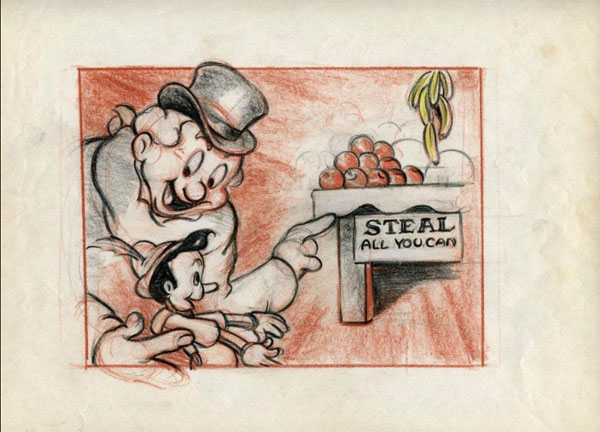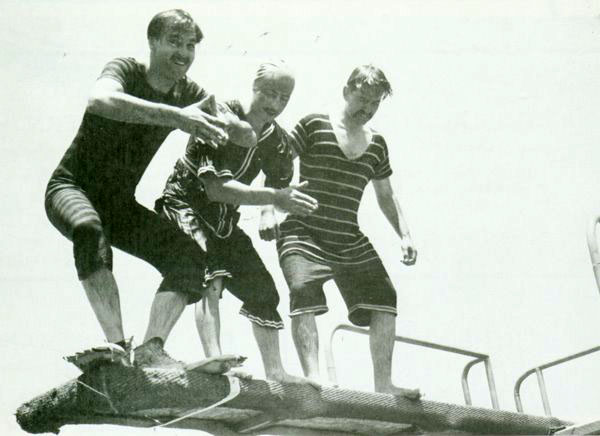Today’s Golden Awards interviews are (again) with two animation veterans who have been largely lost to animation history, Curtiss D. Perkins and Lee Halpern.

Perkins started as an inbetweener for Walter Lantz in 1936 when he was “just out of high school” and “completely green.” He adds that, “it was a little difficult to develop a routine of discipline and knowing everything. It’s not like what people think of drawing. There are rules and regulations and methods of animation that you have to learn. But it was very interesting and I got a kick out of it.” He also obviously likes to point out that “my total salary for three nights overtime and regular time at Lantz was about $18.00 a week. A lot of things have happened since then and I think I’ve made well over that in a day.”

After awhile, he became an effects animator and moved into storyboarding. At Disney, he also got into art direction, and was credited as such on Fantasia; he is also one the artists who helped develop Lee Blair’s storyboard continuity for The Baby Ballet, one of the unproduced segments Disney intended to include in “reissues” of Fantasia. He joined the picket line during the 1941 Disney strike, at which time he was listed as “Sr. Story” earning $47.50 a week. How this affected his career is not clear, but he seems to have served in the Navy Photo Science Lab during World War 2. After the war, he did backgrounds for It’s a Grand Old Nag, Bob Clampett’s 1947 pilot cartoon for Republic, as well as on Clampett’s Beany and Cecil TV series.

Left to right: Jack Dunham, Joe Rinaldi and Curt Perkins at Nasconian Club – Disney’s “Snow White” party, 1938
In the early 50s, he opened his own studio, Sketchbook Film Productions where, he notes, “We had one accomplishment we were very proud of. We had a contract with the U.S. State Department [to make] Tom Schuler—Cobbler Statesmen. At that time, it was the largest animation contract that had ever been let out by the State Department, and we ended up with about a half hour of animation.”
He subsequently did backgrounds for a number of studios, most frequently for Hanna-Barbera (The Flintstones, Scooby Doo, Where Are You!) and Filmation (Star Trek: The Animated Series, several Fat Albert specials). He died in 1996 at the age of 80.

Lee Halpern points out that he began his career at Leon Schlesinger’s on July 21, 1936, a week after Martha Sigall did. He had finished his pre-law education in New York, but went to the West Coast to follow his passion for art by working for Schlesinger. “They gave me a 30-day trial for $6.00 a week. Obviously I made it and after 30 days they gave me a 100% raise.” He recalls working with Ken Harris and then getting into Friz Freleng’s unit. When Art Davis left, Freleng asked him and Art Leonardi “if we were interested in trying out for animation, which we both very happy to do.”
 After working on Warner Bros. shorts in the 1960s as a full animator, he went into TV series work, including brief stints at DePatie-Freleng (The Super 6) and Warner Bros. TV Animation (The Bugs Bunny/Road Runner Hour), then largely worked for Filmation (He-Man and the Masters of the Universe, Ghostbusters and She-Ra: Princess of Power). In his chat with Dan McLaughlin, Halpern ends by talking at length about his sculpture, boasting he was about to be profiled on a local L.A. TV station, where he’ll be discussing his work in both animation and in bronze. Halpern died in 2002 at 86.
After working on Warner Bros. shorts in the 1960s as a full animator, he went into TV series work, including brief stints at DePatie-Freleng (The Super 6) and Warner Bros. TV Animation (The Bugs Bunny/Road Runner Hour), then largely worked for Filmation (He-Man and the Masters of the Universe, Ghostbusters and She-Ra: Princess of Power). In his chat with Dan McLaughlin, Halpern ends by talking at length about his sculpture, boasting he was about to be profiled on a local L.A. TV station, where he’ll be discussing his work in both animation and in bronze. Halpern died in 2002 at 86.
There’s not much readily available on either artist, though the indefatigable Don Yowp posted a brief piece on Tom Schuler—Cobbler Statesmen, which he somewhat mischaracterizes as “one of those Commie-hunting era cartoons that waves the American flag.” (Yes, it is pro-American propaganda, but what do you expect from a film made for the U.S. Information Agency; however, it’s not as right-wing as the John Sutherland animated documentaries as compares it to.) As for Halpern, I should note he shows up briefly as the ambitious inbetweener in The March of Time, the 1939 Schlesinger gag reel, which Steven Hartley provides a convenient breakdown here.
Next week: Lew Irwin and Betty Brenon.


 Harvey Deneroff is an independent film and animation historian based in Los Angeles specializing in labor history. The founder and past president of the Society for Animation Studies, he was also the first editor of Animation Magazine and AWN.com. Harvey also blogs at deneroff.com/blog.
Harvey Deneroff is an independent film and animation historian based in Los Angeles specializing in labor history. The founder and past president of the Society for Animation Studies, he was also the first editor of Animation Magazine and AWN.com. Harvey also blogs at deneroff.com/blog.




































































In the 1940 census, 23 year old Curtiss D. (either Dustin or Dusten, I’ve seen both) Perkins, cartoonist, is listed as having been born in Minnesota, was married, had an income of $1,900, and had 3rd year of high school as his highest educational level. He was living in Glendale, CA. (In the 1930 census, he was listed as living in Minneapolis, MN.) Born April 25, 1916.
I lived next door to Curt and Milly Perkins in Sun Valley for many years,until my parents divorced in 1973.Curt had a studio in the back of their house when he worked on Beany and Cecil backgrounds.They were both the nicest people you could ever hope to know.
this was my grandfather. it’s nice to meet you all.